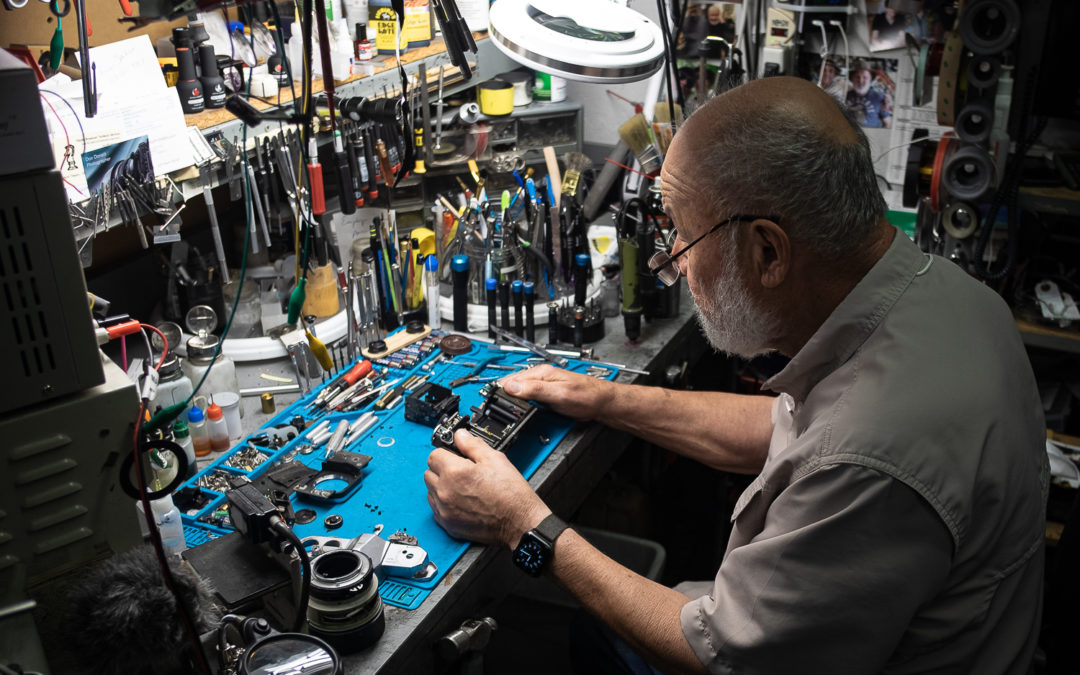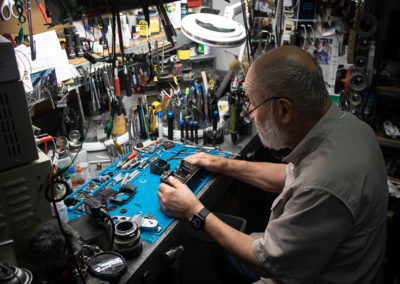It is with heartfelt sadness we announce the unexpected passing of Arizona Photography Alliance friend and mentor, Joe Wojcich. As founder and owner of Tempe Camera, Joe became an important fixture in the lives of many AZPA members throughout the years. Joe died on June 19, 2024 at the age of 77.
Joe pitched in with several photography exhibitions for Phoenix Art Museum through printing and funding. Director Emeritus, Jim Ballinger said, “People don’t often think about the technical support, product availability and enthusiasm that someone like Joe provided to the photographic arts in Arizona. With Joe as a friend to the museum, we could always depend on his answer to pleas of help to be a resounding, ‘Yes!’ With eagerness Joe gave huge technical and product support to the artists in our community.”
Within his staff’s announcement of Joe’s passing they shared, “Joe’s vision and dedication built Tempe Camera into a beloved institution, offering unparalleled service in camera repair, retail sales, equipment rentals and imaging. His legacy is one of passion, excellence and unwavering commitment to both his craft and his community.”
His longevity as a mainstay in the lives of Arizona photographers was celebrated in the Spring of 2022, when AZPA members and long time friends of Joe published two blogs on the occasion of Tempe Camera’s fiftieth anniversary year, outlining Joe’s remarkable career. Thanks to Jeff Luth, Mark Goldstein and Mark Timpany we are honored to republish the two blogs in his memory. Arizona Photography Alliance offers sincere condolences to Joe’s family and his wonderful team at Tempe Camera. He will be sorely missed.
The nearly fifty-year history of Tempe Camera tracks the many changes in photography over that time. We can get an informed view of those changes from its founder and owner Joe Wojcich.
In 1970, Joe Wojcich was working in shipping and receiving at Wilson Camera. The owner, Arthur Hertzfeld, made him an offer: proceeds from sales of any of the backroom broken cameras that Joe could repair would be split 50/50. In a few months’ time, his skills at camera repair were bringing him in an extra $50 each month. The sum was significant. It matched the monthly stipend he was receiving on the GI Bill, and it was a healthy chunk of the $60 he paid each month for rent. Joe Wojcich’s career in camera repair had been launched.
Joe set forth on his own in 1972. In what is now Olympic Hair Design, about a block west of the present-day Tempe Camera, he set up shop. His neighbor did musical instrument repair, and the two businesses fed from each other. Photography and music attracted many of the same people.
The business of camera repair quickly established a need for loaner equipment. Another deal with Art Hertzfeld furnished Joe’s repair customers with loaner cameras that would otherwise have remained dormant or broken at Wilson Camera. With time, the loaner cameras morphed into the lucrative rental business which has remained active to this day. In the ’70s, repairs and rentals represented equal shares of a camera store operation. Currently, rentals are the cash cow with present-day cameras unlikely to be repaired in the field. Manufacturers no longer freely sell repair parts or offer classes in repair to their dealers. Professional photographers no longer rely on repairs from their local camera shops but are users of the service groups of manufacturers like Canon and Nikon who offer fast turnaround repairs or loaners for a yearly fee. Repair technology for today’s electronic-dependent cameras does not travel far from the manufacturer’s premises.
At the time Tempe Camera opened its doors, there were at least eight or nine other competitors. Film processing paid the rent for all of them. It doesn’t take an extensive market survey to see that processing has become a niche market. Some of the classic film stock is no longer available. Some of the processes are lost because of cost or environmental impact. Until digital photography caught hold, Tempe Camera did two shifts for processing. Volume of E-6 (color slide film) was roughly 2000 rolls each week. Suddenly, he says, “like someone turned a switch on, it was gone.” Tempe Camera’s nearby lab still operates, primarily offering printing for large-sized prints.
Proprietary technology has moved us beyond the era when the Associated Press (AP) could deliver 10 Canon lenses to Joe Wojcich, and he could return them modified to operate in a Nikon body in about two weeks, in time for the Moscow Olympics. The Canon 400mm f4.5 was the preferred glass by the AP sports photographers for a decade to follow, adapted to the Nikon body they knew.
Much of film use today is driven by the students. There are a few wedding photographers that still shoot film. The cost of film stock and processing puts it out of reach for the casual photographer. “I don’t know how much longer film is going to be around,” says Joe.
New camera sales have been significant for Tempe Camera through most of its history. Nikon, Canon, Fuji, and Sony have been mainstays for a long time. They were also major dealers for Olympus until that company fell on hard times. Today new camera sales account for about 25 percent of Tempe Camera revenues. The popular camera classes have been halted during the pandemic.
Joe’s favorite amongst the digital camera lines is Fujifilm. Operation is very straightforward with cost being considerably scaled back from the competition. Fuji lenses have always been highly regarded. Along with their X series cameras using APS-C size sensors, their newer GFX line has taken the lead in medium format digital gear. The GFX series cameras produce 50- or 100-megapixel images with a camera body that handles much like the Canon or Nikon full frame equipment.
Many of the staff have been with Tempe Camera for a long time, with 20-year and 30-year veterans quite common. Tempe Camera’s general manager has been with the store 40 years. Staff numbers have shrunk over the years. Today’s staff of around 30 is about half the size from 15 years back. The repair department has shrunk even more. There are two people now, down from six in the days before precision mechanical assemblies were replaced by proprietary electronics modules. Joe’s first employee in the repair shop was taught all there was to know about projector repair, both movie and slide projectors. He was aware that this would not be a lifetime occupation and later left to work in the computer field. Several years back, all the projector inventory of Tempe Camera was disposed of, along with the dust it had accumulated over several years of display and storage.
Joe Wojcich has had a front row seat on technical changes in photography for over 50 years. He describes his life in photography as, “50 years on the bench.” He has considered retiring, but would hope to find someone to take over the operation who could replace him on the repair bench. Unhappily, camera repair expertise, outside of some factory technicians familiar with a single line of equipment, has become a very rare commodity.
Next year, Tempe Camera will celebrate its golden Anniversary. April 1, 2022 will mark 50 years since incorporation. Joe considers, “We had a good run.”

Mark Timpany
Contributing Writer
Mark Timpany has been interested in photography most of his life. His father was an amateur photographer who introduced him to the smell of the stop bath, the roar of the print washer. There were a number of lean years without access to a darkroom, but after retirement as a broadcast engineer and the advent of digital technology, he has the time and means to keep making photographs. AZPA has been the resource that keeps him in touch with all things photographic in Arizona.
Contact Mark
Instagram: @mwtimpany
SmugMug: travelblogue.co
Blog: bamiyan.us


